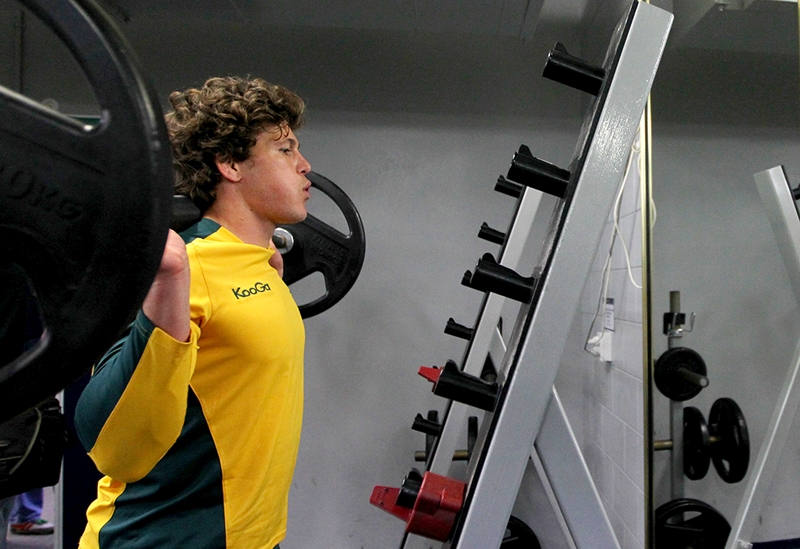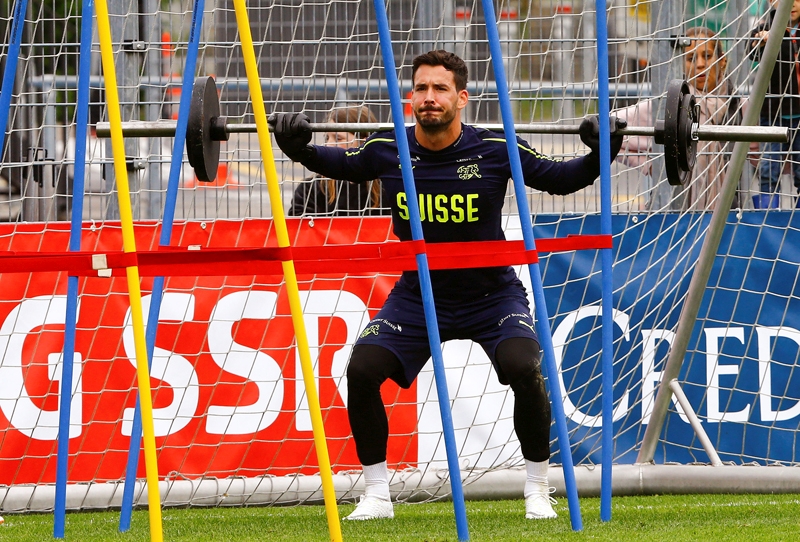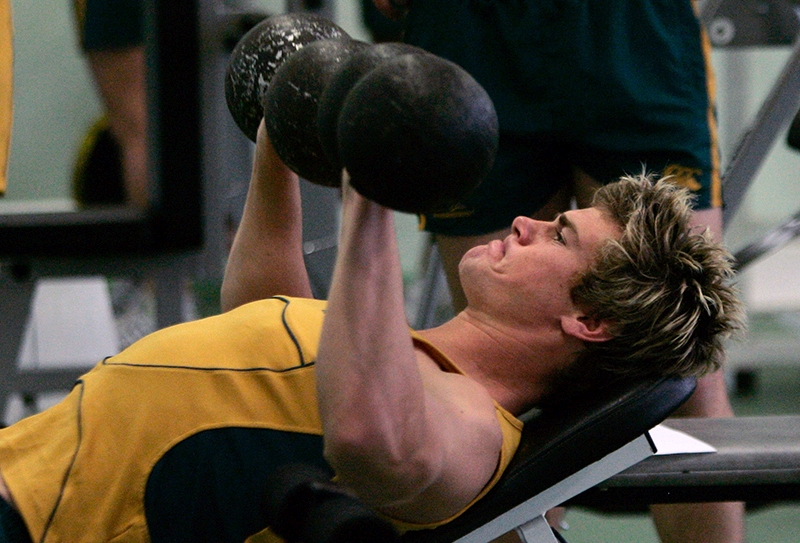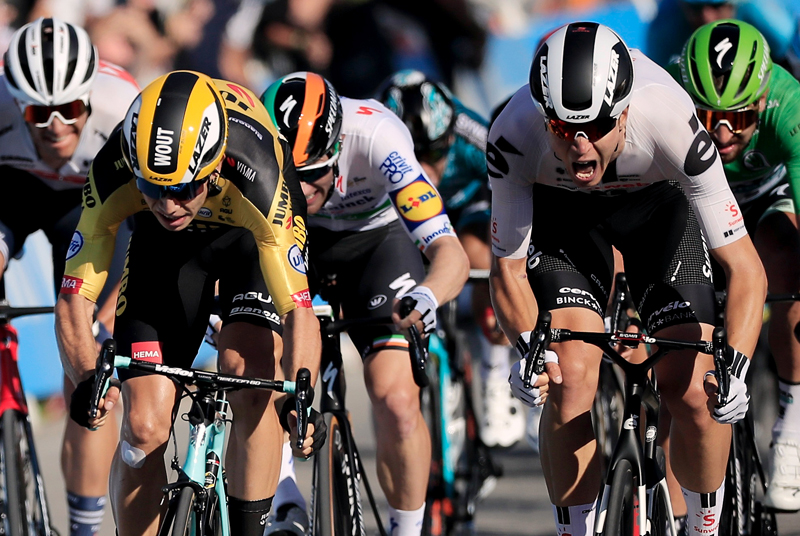You are viewing 1 of your 1 free articles. For unlimited access take a risk-free trial
More strength, better endurance, fewer injuries, less time

Many endurance athletes are aware that strength training brings a number of benefits to endurance performance, but feel they simply don’t have time to strength train. But as this ‘back-to-basics’ article explains, less time spent in the gym is likely to produce greater benefits because shorter, more intense strength sessions are the key
In case you weren’t already aware of it, strength training is one of the very best ways to enhance endurance performance. For starters, strength training has been proven to reduce the risk of injury – and less injury means less interruption to training, leading to improved performance. In one recent review study (drawing together the findings from a number of previous studies) of the scientific literature, researchers found that a direct relationship between strength training and reduced injury, with a 10% increase in strength training leading to a 4% reduction in injury rates(1) .But strength training doesn’t just reduce the incidence of injuries – it can significantly enhance endurance performance too. Another recent review study explored the impact of adding strength training to a range on endurance sports including in running, cycling, cross-country skiing, and swimming(2). It found clear improvements in the middle and long-distance performance of athletes that incorporated strength training to their programs. The performance gains came about due to the following:
- *Improvements in the energy cost of locomotion (ie greater efficiency with less energy required to maintain a given pace – see more on efficiency here)
- *Higher levels of maximum force
- *Higher levels of peak and sustainable power
When time is tight
If strength training is so beneficial for endurance athletes, why do so few strength train? Undoubtedly, one of the biggest factors is time; many athletes already struggle to fit in their endurance training around work and family commitments. Adding a few more hours for strength training is often seen as impossible. However, there’s good news because more time spent in the gym is not necessarily better. Recent research conducted in men and women, trained and untrained has demonstrated that lower weekly volumes of strength training (5-10 sets per body part per week) can actually lead to better strength gains than high volumes (10+ sets per week)(3-5).Why doesn’t more time invested doesn’t automatically mean better results? Well, it’s all about training quality. High-quality, intense training, which stresses the muscle fibers sufficiently, will invariably produce a training stimulus, even if that training is brief in duration. This stimulus will in turn will result in muscle adaptation and strength/power gains. However no amount of low-quality/low-intensity training will produce meaningful adaptation because it simply won’t stress the muscle tissues adequately.
As an analogy, think of a coconut shy at the fairground. If you throw a marble, no amount of direct hits on the coconut will dislodge it, even if you were to work your way through hundreds or even thousands of marbles. Yet one accurately aimed brick would very quickly produce the powerful stimulus you want and dislodge that coconut from its perch!
Intensity importance
The obvious question then is what should be the ‘brick’ in your training armory to produce the intensity and training stimulus you need to build strength and muscle? The answer in a word is ‘intensity’. However, although it’s a simple word, intensity as a concept when applied to strength training is sometimes hard to grasp, especially for novice athletes.Generating intensity in a resistance workout is most definitely not about running round the gym like a headless chicken throwing the weights about with poor form. What it is about is making your muscles perform a greater volume of hard work per unit of time. For example, if you’ve ever had to cram your normal 60-minute strength session into just 40 minutes because you were short of time, you may have noticed how much you ‘felt’ the effects the next day. The reason is simple; in an effort to fit all your exercises in, you probably moved swiftly round the gym, using whatever machine or free weights happened to be available at the time with barely a pause between sets. You unwittingly generated increased intensity! This approach is backed up by research, which has found that performing more work in a shorter time period (by using shorter rest intervals, thus creating create higher intensity in a strength session) not only saves time, but results in excellent strength gains too(6).
Unfortunately, many athletes get confused about how to generate intensity. Just to reiterate, it’s all about performing more muscular work per unit of time; this means that performing more sets, more reps and longer workouts are most definitely NOT prerequisites for generating more intensity, and by lengthening workouts, can even end up reducing it! The four principles of generating intensity are shown below; by applying these to any strength workout, you will generate the number one ingredient for success - intensity.
Four principles of intensity
Although there are certain techniques that you can employ to help create more intense workouts (see below), there are four ‘intensity fundamentals’ you need to have in place first, regardless of the particular routine you’re following. Notice how principles 1 & 2 will lead to shorter duration workouts when applied:1) Minimize rest – Keep the rest between sets to a minimum, even if you’re doing multiple sets per body part. The best way of achieving this is to use the rest period to perform a different exercise targeting a different muscle group. This technique is known as ‘supersets’ – see below;
2) Move swiftly – This doesn’t mean rushing your sets, but rather than chatting to friends about last night’s TV shows, or contemplating your navel, it means moving immediately from one strength exercise to another. This minimizes ‘down’ time, helping create extra intensity;
3) Train to high fatigue - To really stimulate your muscles intensely, you need to generate high levels of fatigue by ensuring that at the end of each set, it is becoming very difficult to squeeze out another rep while maintaining strict form, no matter how hard you try - sometimes referred to as reaching failure point. The exception to the rule is beginners, who should train to the point of moderate fatigue rather than failure in order to avoid excessive soreness.
4) Train strict – Although you should move swiftly through your workout minimizing any downtime, you must maintain proper form at all times by performing full range, smooth movements and avoiding rushed or jerky efforts, even when you become fatigued. Remember, your goal is to build strength, rather than demonstrate it!
Practical ideas
By this point, you should be getting a feel for what’s involved in generating intensity; by applying the four general intensity principles above to your existing strength workouts, you can increase the intensity of your training while simultaneously reducing the duration of your workouts. If you’re relatively new to strength training, these principles alone will produce great results, although complete beginners should spend a few weeks training to fatigue before pushing to failure (principle 3) in order to avoid excessive soreness.However, while more experienced athletes will also benefit from the application of these general principles, there inevitably comes a time (if for example you reach a plateau in your training) when other tools are needed to produce more intensity and hence a greater training stimulus. However, before you try deploying some of these ‘intensity tools’, don’t forget that you can also increase training stimulus by ‘shocking’ the muscle with unexpected movements. There are two ways of achieving this:
- #Alternative exercises - while the movement may be similar, the subtle changes in the range and angle of movement in a different exercise for a particular body part mean that the target muscle fibers will receive a different training stimulus. This ‘new’ stimulus is usually enough to produce an increased training response. For example, if you’re used to machine bench presses, performing bench presses with a barbell and free weights creates plenty of new training stimuli within the chest muscles;
- #Change of order –, After a few workouts, your central nervous system and muscles ‘learn’ what to expect next in the routine and adaptation takes place to make that particular order as efficient and easy as possible. While this is great for getting through a routine with the minimum of effort, it’s not so good for creating training intensity. Simply swapping the order of your exercises can generate quite a bit of surprise and shock for muscles expecting something different!
Intensity tools
Once you’ve become accustomed to substituting alternative exercises into your routine and swapping its order, you can then move on to some more advanced tools, which will dramatically increase training intensity. Because they’re quite a step up, these techniques are not really suitable for beginners, and even experienced athletes should exercise caution when trying them out for the first time. If in doubt, seek advice from a qualified trainer or coach about how to incorporate them into your existing routine:- *Supersets –Supersets take advantage of the agonist/antagonist principle by working pairs of muscles back to back without pausing in between, effectively eliminating the ‘dead time’ in between sets that occurs when you work the same muscle consecutively with multiple sets and hang around while recovery takes place. To put together a superset, all you need to do is choose an agonist/antagonist pair of muscle groups (eg biceps/triceps, quadriceps/hamstrings etc) and alternate the sets performed on each group, ensuring you switch straight from agonist to antagonist and back again without pausing;
- *Giant sets – These are an extension of supersets consisting of around 3-6 different exercises performed in quick succession without rest in between the exercises, and which should be chosen to target either a single muscle or an agonist/antagonist muscle pair (eg bench press, pec deck, dumbbell flyes and dips for the chest muscles);
- *Negative sets – This technique takes advantage of the fact that your muscles can sustain more force during a negative contraction (when lowering a weight) than during a positive one (ie during the lifting phase). In negative sets, you select a weight that is 25-50% higher than your normal training weight and get a training partner to assist you by supplying some help during the lifting phase. At the top of the lift, you lower all the weight yourself smoothly and slowly. This procedure is repeated for 8-10 reps until a set is completed. Negative sets is an advanced technique and as well as producing jellied muscles in no time all, you’re likely to experience more post-exercise soreness and stiffness than usual. You have been warned (read more here)!
- *Strip down sets –After performing your normal set of reps to exhaustion, have a training partner immediately change the pin position to remove about a third of the weight on the machine stack (or pass you lighter dumbbells/barbells with about a third less weight). You then immediately perform another set, aiming for around 6-8 extra reps at this lighter weight or until you reach failure. The first couple of reps at the lighter weight will feel quite easy, but you’ll very rapidly experience crushing fatigue! By dropping the weight and then continuing using a lighter weight, you are effectively creating a ‘double failure point’ in the same set. You can repeat this process by removing more weight and going again, although most people find that two failures in one set is quite enough!
- *Pre-exhaustion –this technique was pioneered by the late Arthur Jones, the founder of the ‘Nautilus’ fitness equipment company and an eccentric genius (read more here)! Pre-exhaustion isolates a target muscle group with a single isolation movement, works it to exhaustion then immediately (absolutely no rest!) follows this movement with a compound exercise for the same body part using ‘helper’ muscles. During the compound exercise, the (fresh) helper muscles help to drive the already tired target muscles into an even deeper state of exhaustion. For example, to work the chest, the pec deck is used to isolate chest muscles immediately followed by bench press, where the (fresh) triceps muscles of the rear arms force the chest muscles to continue working, pushing them into an even deeper state of fatigue. Other combinations include side lateral raises/shoulder press (for deltoids), leg extensions/squats (for quadriceps) reverse flyes/bent over rows (for upper back) and so on.
References
- Br J Sports Med. 2018 Dec;52(24):1557-15
- Int J Sports Physiol Perform. 2018 Jan 1;13(1):57-63
- Int J Sports Physiol Perform. 2019 Jun 12:1-23
- Med Sci Sports Exerc. 2019 Mar;51(3):515-52
- Sports Med. 2015 Dec;45(12):1693-720
- J Sports Sci Med. 2015 May 8;14(2):269-75
Newsletter Sign Up
Testimonials
Dr. Alexandra Fandetti-Robin, Back & Body Chiropractic
Elspeth Cowell MSCh DpodM SRCh HCPC reg
William Hunter, Nuffield Health
Newsletter Sign Up
Coaches Testimonials
Dr. Alexandra Fandetti-Robin, Back & Body Chiropractic
Elspeth Cowell MSCh DpodM SRCh HCPC reg
William Hunter, Nuffield Health
Keep up with latest sports science research and apply it to maximize performance
Today you have the chance to join a group of athletes, and sports coaches/trainers who all have something special in common...
They use the latest research to improve performance for themselves and their clients - both athletes and sports teams - with help from global specialists in the fields of sports science, sports medicine and sports psychology.
They do this by reading Sports Performance Bulletin, an easy-to-digest but serious-minded journal dedicated to high performance sports. SPB offers a wealth of information and insight into the latest research, in an easily-accessible and understood format, along with a wealth of practical recommendations.
*includes 3 coaching manuals
Get Inspired
All the latest techniques and approaches
Sports Performance Bulletin helps dedicated endurance athletes improve their performance. Sense-checking the latest sports science research, and sourcing evidence and case studies to support findings, Sports Performance Bulletin turns proven insights into easily digestible practical advice. Supporting athletes, coaches and professionals who wish to ensure their guidance and programmes are kept right up to date and based on credible science.












